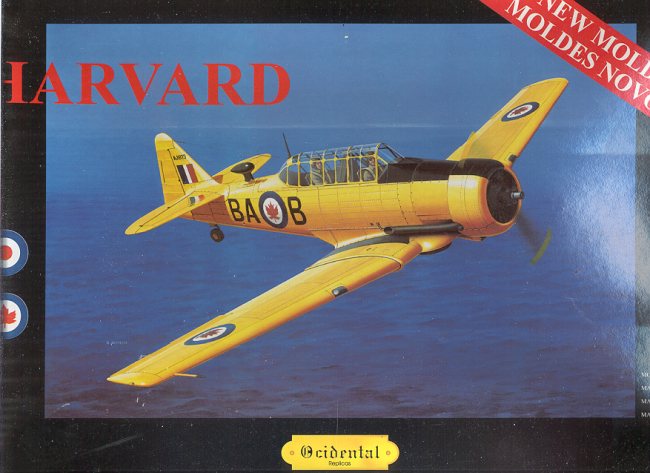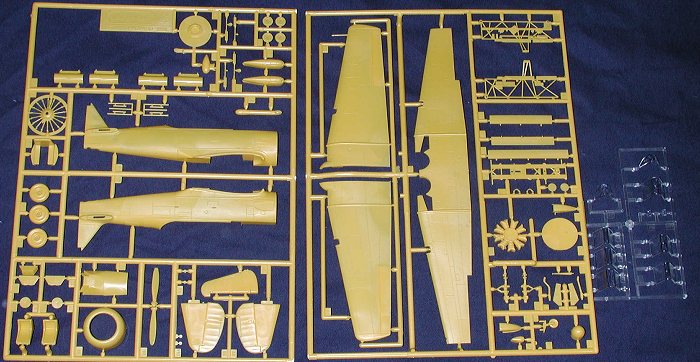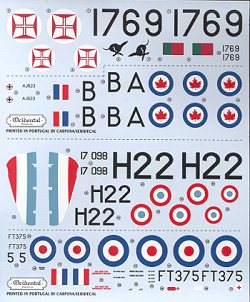
| KIT: | Ocidental 1/48 Harvard |
| KIT # | 0211 |
| PRICE: | $25.00 |
| DECALS: | Four Aircraft |
| REVIEW & | |
| NOTES: |

| HISTORY |
Undoubtedly THE most recognized and most flown in propdriven military trainer in the history of aviation has to be the North AmericanT-6 Texan. A design that just looks right and put North American on the road tosuccess, the T-6 saw continuous military service from the early 40s to the early90's when it was finally retired from the South African Air Force. There maystill be some in service with other military units that I am not aware of, butfrankly, 50 years is a heck of a long time.
Thanks to its robust construction, there are quite a largenumber of these planes still flying in the hands of warbird enthusiasts all overthe world. The National Air Races held every year in Reno, Nevada even has acategory for the T-6.
What is particularly intriguing about the T-6/Harvard is that itis not a particularly easy plane to fly! It was said that if you could masterthe Harvard, that flying a fighter would be a piece of cake. Brian Silcox's bookBest of the Past pointed out this particularpiece of information and it was quite a surprise to me. The Harvard was aversion of the T-6 that was specifically built by Canadair to meet Commonwealthtraining requirements and is a bit different from the T-6. Externally the aftcanopy and exhaust are giveaways to the Harvard. Inside, the throttles arereversed to what is normal in US planes. Whether this has been changed bywarbird owners, I'm not sure.
Like the T-6, many Harvards were modified in the early 50's tomeet what was current training requirements. Most of the changes were toavionics systems as well as larger panes of plexiglass in the canopysections. Some aircraft were fitted with wiring for underwing hard points sothat the aircraft could be used as COIN birds. Other than that, these were thesame planes that were built during the war.
| THE KIT |

Molded in alovely yellow plastic, the Ocidental kit at first glance seems to be based onthe Monogram kit. However, it is a new tool and only superficially similar.After all, there are only so many ways of designing a kit! Unlike the Monogramversion, this one has fully engraved panel lines, a goodly selection ofunderwing ordnance and separate canopy sections. The interior is very nicelydone giving a full floor and side detailing. You also get both types of canopysections; those with and without extra bracing.
This kit is alsoa Harvard, not a T-6. The biggest difference is the aft canopy section. TheT-6's is shorter and the sheet metal area there is flat. On the Harvard, it is abit longer and the sheet metal portion curves up. There is also the long exhaustpipe that is normal with most Harvards. This allowed heat to be brought into thecockpit as much training was done in Canada where it gets a mite chilly in thewinter! It also appears that this kit might have a P-51D tail wheel, anoften-made modification.
 The instructions are really super. In addition to nice, clearconstruction steps, there are a myriad of photos of the real aircraft to assistthe builder. Color callouts are given though only in a generic way and not withFS numbers. There is a large decal sheet offering markings for four aircraft.One each from Portugal, Canada, France and Great Britain. All except the Portugueseversion are in overall yellow, hence the color of the plastic. The decalsthemselves are printed by Carpena so are of a very high quality. There are alsophotographs of each of the aircraft depicted on the sheet which is a very niceaddition.
The instructions are really super. In addition to nice, clearconstruction steps, there are a myriad of photos of the real aircraft to assistthe builder. Color callouts are given though only in a generic way and not withFS numbers. There is a large decal sheet offering markings for four aircraft.One each from Portugal, Canada, France and Great Britain. All except the Portugueseversion are in overall yellow, hence the color of the plastic. The decalsthemselves are printed by Carpena so are of a very high quality. There are alsophotographs of each of the aircraft depicted on the sheet which is a very niceaddition.
Overall, this looks like a super kit. Despite havingbeen around for many years, I have never seen one built (of course, I don't seetoo many Monogram AT-6s either). I'll let the rivet counters fuss over anyinaccuracies, but it sure looks like it will build into a very nice model.
If you would like your product reviewed fairly and quickly by asite that averages over 2,300 visits a day, please contactme or see other details in the